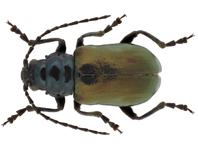Abstract
Two new species of deep-sea chrysogorgiid gorgonians are described from the tropical Western Pacific: Iridogorgia densispicula n. sp. from an unnamed seamount in the Caroline Plate with water depth of 1204 m and Iridogorgia squarrosa n. sp. from an unnamed seamount near the Mariana Trench with water depth of 1458 m. Iridogorgia densispicula n. sp. has a slender stem with bud-like polyps, dense sclerites in polyps and branches, spindle-like scales in polyp bases, and long rods in tentacles. Iridogorgia squarrosa n. sp. has a brown to nearly black axis, large polyps with eight obvious columns, elongated scales in the back of tentacles, and special scales at base of polyps with many sculptures. By the combination of these features, the two new species differ distinctly from each other and all other congeners. Phylogenetic analyses indicate that I. densispicula n. sp. is sister to all other Iridogorgia Verrill, 1883, while I. squarrosa n. sp. showed close relationship with I. splendens Watling, 2007.
References
Agassiz, A. (1888) Three cruises of the United States Coast and Geodetic Survey steamer “Blake” in the Gulf of Mexico, in the Caribbean Sea, and along the Atlantic coast of the United States, from 1877 to 1880. 2 Vols. Houghton, Mifflin & Company, Boston, 334 pp.
https://doi.org/10.5962/bhl.title.2049
Alfaro, M.E., Zoller, S. & Lutzoni, F. (2003) Bayes or Bootstrap? A simulation study comparing the performance of Bayesian Markov chain Monte Carlo sampling and bootstrapping in assessing phylogenetic confidence. Molecular Biology and Evolution, 20 (2), 255–266.
https://doi.org/10.1093/molbev/msg028
Bayer, F.M., Grasshoff, M. & Verseveldt, J. (1983) Illustrated Trilingual Glossary of Morphological and Anatomical Terms Applied to Octocorallia. E.J. Brill/Dr. W. Backhuys, Leiden, 75 pp.
Darriba, D., Taboada, G.L., Doallo, R. & Posada, D. (2012) jModelTest 2: more models, new heuristics and parallel computing. Nature Methods, 9, 772.
https://doi.org/10.1038/nmeth.2109
Deichmann, E. (1936) The Alcyonaria of the western part of the Atlantic Ocean. Memoirs of the Museum of Comparative Zoology, Harvard, 53, 1–317.
https://doi.org/10.5962/bhl.title.49348
Ehrenberg, C.G. (1834) Beiträge zur physiologischen Kenntniss der Corallenthiere im allgemeinen, und besonders des rothen Meeres, nebst einem Versuche zur physiologischen Systematik derselben. Abhandlungen der Königlichen Akademie der Wissenschaften, Berlin, 1, 225–380.
Grasshoff, M. (1999) The shallow-water gorgonians of New Caledonia and adjacent islands (Coelenterata, Octocorallia). Senckenbergiana biologica, 78, 1–121.
Guindon, S., Dufayard, J.F., Lefort, V., Anisimova, M., Hordijk, W. & Gascuel, O. (2010) New algorithms and methods to estimate maximum-likelihood phylogenies: assessing the performance of PhyML 3.0. Systematic Biology, 59, 307–321.
https://doi.org/10.1093/sysbio/syq010
Hall, T.A. (1999) BioEdit: a user-friendly biological sequence alignment editor and analysis program for Windows 95/98/NT. Nucleic Acids Symposium Series, 41, 95–98.
Haeckel, E. (1866) Generelle morphologie der Organismen. Vol. 2. Verlag von Georg Reimer, Berlin, 652 pp.
https://doi.org/10.1515/9783110848281
Herrera, S., Baco, A. & Sánchez, J.A. (2010) Molecular systematics of the bubblegum coral genera (Paragorgiidae, Octocorallia) and description of a new deep-sea species. Molecular Phylogenetics and Evolution, 55 (1), 123–135.
https://doi.org/10.1016/j.ympev.2009.12.007
Hillis, D.M. & Bull, J.J. (1993) An empirical test of bootstrapping as a method for assessing confidence in phylogenetic analysis. Systematic Biology, 42 (2), 182–192.
https://doi.org/10.1093/sysbio/42.2.182
Katoh, K. & Standley, D.M. (2013) MAFFT Multiple Sequence Alignment Software version 7: improvements in performance and usability. Molecular Biology and Evolution, 30, 772–780.
https://doi.org/10.1093/molbev/mst010
Kükenthal, W. (1919) Gorgonaria. Wissenschaftliche Ergebnisse der Deutschen Tiefsee- Expedition auf dem Dampfer „Valdivia“ 1891–1899, 13 (2), 1–946.
Lamouroux, J.V.F. (1812) Extrait d’un mémoire sur la classification des polypiers coralligènes non entièrement piérreux. Nouveau Bulletin des Sciences, Société Philomathique de Paris, 3 (63), 181–188.
McFadden, C.S., Benayahu, Y, Pante, E, Thoma, J.N., Nevarez, P.A. & France, S.C. (2011) Limitations of mitochondrial gene barcoding in Octocorallia. Molecular Ecology Resources, 11, 19–31.
https://doi.org/10.1111/j.1755-0998.2010.02875.x
Nutting, C.C. (1908) Descriptions of the Alcyonaria collected by the U.S. Bureau of Fisheries steamer Albatross in the vicinity of the Hawaiian Islands in 1902. Proceedings of the United States National Museum, 34, 543–601.
https://doi.org/10.5479/si.00963801.34-1624.543
Pante, E., France, S.C., Couloux, A., Cruaud, C., McFadden, C.S., Samadi, S. & Watling, L. (2012) Deep-Sea Origin and In-Situ Diversification of Chrysogorgiid Octocorals. PLoS ONE, 7 (6), e38357.
https://doi.org/10.1371/journal.pone.0038357
Pante, E., Abdelkrim, J., Viricel, A., Gey, D., France, S.C., Boisselier, M.C. & Samadi, S. (2015) Use of rad sequencing for delimiting species. Heredity, 114, 450–459.
https://doi.org/10.1038/hdy.2014.105
Ronquist, F.R. & Huelsenbeck, J.P. (2003) Mrbayes 3: Bayesian phylogenetic inference under mixed models. Bioinformatics, 19, 1572–1574.
https://doi.org/10.1093/bioinformatics/btg180
Sánchez, J.A., Lasker, H.R. & Taylor, D.J. (2003) Phylogenetic analyses among octocorals (Cnidaria): mitochondrial and nuclear DNA sequences (lsu-rRNA, 16S and ssu-rRNA, 18S) support two convergent clades of branching gorgonians. Molecular Biology and Evolution, 29, 31–42.
https://doi.org/10.1016/S1055-7903(03)00090-3
Tamura, K., Stecher, G., Peterson, D., Filipski, A. & Kumar, S. (2013) MEGA6: Molecular Evolutionary Genetics Analysis Version 6.0. Molecular Biology and Evolution, 30 (12), 2725–2729.
https://doi.org/10.1093/molbev/mst197
Verrill, A.E. (1883) Report on the Anthozoa, and on some additional species dredged by the “Blake” in 1877-–1879, and by the U.S. Fish Commission steamer “Fish Hawk” in 1880-82. Bulletin of the Museum of Comparative Zoology at Harvard College, 11, 1–72.
Versluys, J. (1902) Die Gorgoniden der Siboga-Expedition I. Die Chrysogorgiidae. Siboga-Expeditie, 13, 1–120.
Watling, L. (2007) A review of the genus Iridogorgia (Octocorallia: Chrysogorgiidae) and its relatives, chiefly from the North Atlantic Ocean. Journal of the Marine Biological Association of the UK, 87, 393–402.
https://doi.org/10.1017/S002531540705535X
Watling, L., Rowley, S. & Guinotte, J. (2013) The World’s largest known Gorgonian. Zootaxa, 3630 (1), 198–199.
https://doi.org/10.11646/zootaxa.3630.1.10

